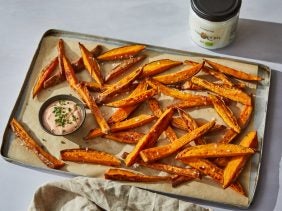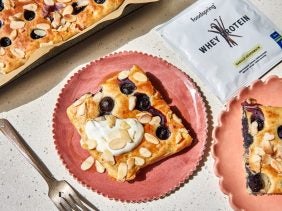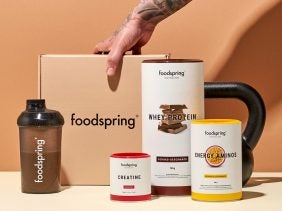Rhubarb: The vegetable that’s not like the others
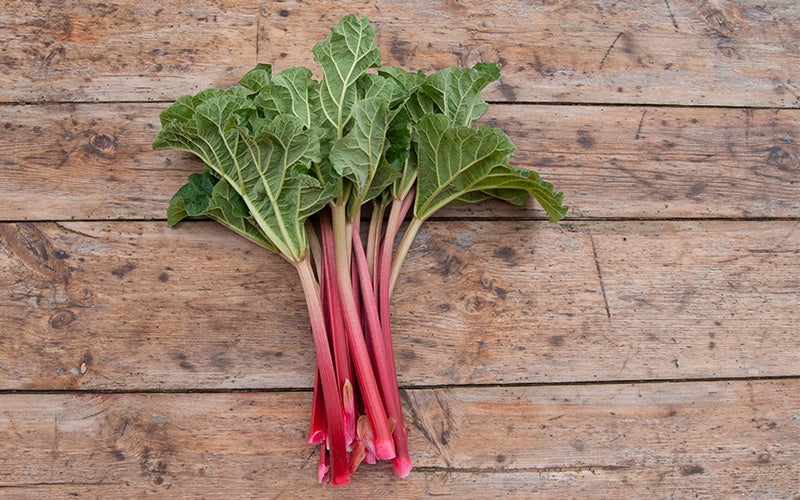 ©Veronika Roosimaa
©Veronika Roosimaa
Rhubarb is undeniably special. It’s technically a vegetable but it cooks like a fruit, and it’s excellent in everything from rhubarb compote to strawberry rhubarb pie. And it’s in season during the spring, which means it’s about to be everywhere! If you don’t have a lot of rhubarb knowledge, find out everything you need to know about this funky fruit below.
Rhubarb: fruit or vegetable?
Spring just wouldn’t be the same without at least one slice of iconic strawberry-rhubarb pie. Although most famous for appearing in sweet treats, rhubarb is actually a vegetable and can even be cooked in savory ways.
Rhubarb is a member of the Polygonaceae family and you may not recognize it in its original state. The part we get at the farmers’ market is actually the stalk of the plant, which doesn’t bear actual fruit but instead has very large, inedible leaves.
There are several different rhubarb varieties, each with its own distinctive flavor. The greener the stalks and flesh, the more bitter and acidic it will taste. If the stalks are red, your rhubarb will be soft and sweet.
Nutrients in rhubarb
In addition to having a unique, refreshing taste, rhubarb is an ingredient that’s also particularly low in calories. On the other hand, many preparations of rhubarb are full of sugar to counteract the tart flavor. As with any food, this vegetable, in all of its forms, is best when enjoyed in moderation.
As for the nutrients rhubarb contains, it’s full of many important minerals like potassium and phosphorus, as well as plenty of fiber and vitamins A and C. It owes its special taste to a large concentration of naturally occurring acids like citric and malic acid.
Raw Rhubarb: Nutrients per 100g
| Calories | 21 cal |
| Carbohydrates | 4.5g |
| Protein | 0.9g |
| Water | 93g |
| Fat | 0.2g |
| Saturated fat | 0.05g |
| Unsaturated fat | 0.03g |
| Polyunsaturated fat | 0.09g |
Does rhubarb contain anything harmful?
Rhubarb owes its sourness to a dicarboxylic acid called oxalic acid. It’s a fairly powerful acid that can be toxic in large amounts. But are there any real risks to eating it occasionally?
Most of the acid is found in the rhubarb leaves, which is why we don’t eat the leaves. There’s a bit in the stalk as well, but far less. Still, it’s generally not recommended to eat rhubarb in large quantities. Many report that it creates the sensation of having rough teeth.
Not to mention, this acid is also known to be a “calcium thief” because it prevents our bodies from absorbing the calcium in rhubarb. Thankfully, this problem can easily be eliminated with the right preparation. Peeling, blanching, and cooking are great ways to ensure that the acid content decreases. There is one small downside, and an important point to note: You can’t reuse the cooking water.
Once you’ve taken all of these steps, it’s unlikely that you’ll experience symptoms of oxalic acid intoxication. Eating rhubarb occasionally presents no real danger to your health. Do be careful if you have kidney diseases like kidney stones, as the acid can worsen those conditions. This also applies for beets, spinach, and sorrel.
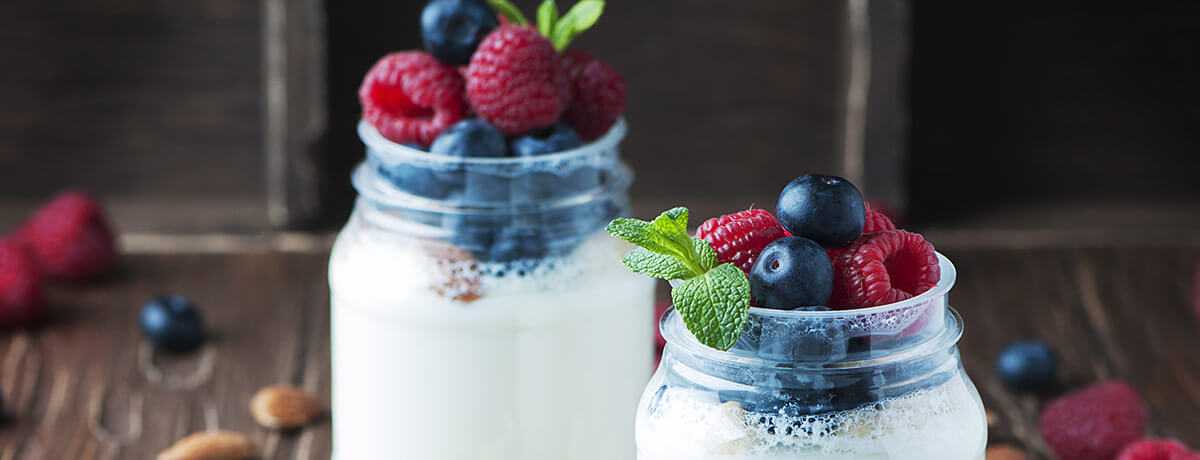
Our tip: Combine rhubarb with dairy products like yogurt, cottage cheese, or whipped cream for a delightful, nutritious treat. The calcium from these dairy products will bind with the rhubarb’s oxalic acid, so it won’t be left free to be absorbed by your digestive system.
When is the best season to eat rhubarb?
Peak season for this veggie is from early spring in April to the end of June. Use rhubarb season as an opportunity to stock up on the vegetable at the grocery store and preserve it to enjoy all year long.
Rhubarb has such a short season because the plants need a very long time to recover their growth after the harvest. That’s the only way to guarantee a successful crop in the following years. What’s more, the plant’s oxalic acid content increases as it ages. So steer clear of any stalk that turns up in July!
How to cook rhubarb
Let’s get down to rhu-business. You don’t have to be a culinary expert to prepare this finicky vegetable. Start by washing the rhubarb stalks thoroughly under running water, then use a vegetable peeler to remove the fibrous outer layer. In some cases, you may be able to simply remove the outer layer with your hands. Finally, trim the ends, which are usually dried out, tough, and not really worth eating. If you’re trying to cut back on food waste, freeze all the parts you don’t use for future use in a syrup or tea.
From there, all you have to do is pick the rhubarb recipes you want to make. For example, you can cut the stalks into small pieces and prepare it like a vegetable to enhance savory meals like curried lentils or crunchy, raw salads. In general, though, rhubarb is more frequently used in sweet recipes like strawberry rhubarb pie. It can be cooked in a pan, baked in an oven, or even blended into a smoothie.
One final tip: Rhubarb will stay good to eat for longer if you wrap it in a damp cloth and put it in the crisper drawer of your refrigerator. Or freeze it by peeling it, cutting it up into small pieces, and packing it in an airtight bag to prevent freezer burn. You can even dehydrate it if you’re up for it! There are so many ideas out there to preserve this punchy spring vegetable.
Rhubarb Crumble Recipe
Nothing will make you drool faster than the sight of a sumptuous rhubarb coffee cake on the table. That makes it one of our absolute favorites. In traditional recipes, a fair amount of sugar and fat goes into these treats. If you’d like a version that tastes just as good but won’t get in the way of your weight loss or fitness goals, our recipe has just what you need.
To make it, you’ll need six red rhubarb stalks, 100g of oatmeal, 100g of wholegrain spelt flour, four tablespoons of maple syrup, two tablespoons of coconut oil, two teaspoons of xylitol, and one teaspoon of cinnamon.
Once you’ve assembled your recipes, begin by preheating the oven to 180 degrees. Wash, peel, and cut the rhubarb into small pieces, the transfer to an oven-safe casserole. In a bowl, mix the wholegrain spelt flour, oatmeal, coconut oil, maple syrup, xylitol, and cinnamon with your hands until a sandy dough begins to form. Spread the mixture evenly over the rhubarb, transfer to the oven, and let bake for 30 minutes.
Our tip: We recommend enjoying this rhubarb dessert with a side of fresh strawberries and a spoonful of our Hazelnut & Whey Duo Protein Cream. It’s a creamy spread combining rich chocolate-hazelnut with sweet whey, and it perfectly complements the dish with no added sugar!

Rhubarb: Our conclusion
- Rhubarb is actually a vegetable, but it’s often prepared in sweet ways like pies, compotes, and more.
- The leaves are inedible and the stalks are tart and crunchy.
- The color of the rhubarb plant says a lot about its taste: the red varieties are sweeter, the green ones are more bitter and acidic.
- The rhubarb plant is rich in nutrients and contains many vitamins and minerals.
- The vegetable contains acids that can be toxic when overconsumed. When eaten in reasonable quantities, it doesn’t present any danger to health.
- Ready to dive in? Rhubarb can be used in many ways, whether to add a tart zing to sweet or savory dishes.
Sources for this article
We at foodspring use only high-quality sources, including peer-reviewed studies, to support the facts within our articles. Read our editorial policy to learn more about how we fact-check and keep our content accurate, reliable, and trustworthy.
- U.S. Department of Agriculture (2019): Rhubarb, raw https://fdc.nal.usda.gov/fdc-app.html#/food-details/167758/nutrients
- Bundeszentrum für Ernährung (2019): Ist Rhabarber ein Kalziumräuber? http://www.bzfe.de/inhalt/ist-rhabarber-ein-kalziumraeuber-33857.html
- Bundeszentrum für Ernährung (2020): Rhabarber http://www.bzfe.de/inhalt/rhabarber-32744.html
- Bundeszentrum für Ernährung (2019): Rhabarberzeit http://www.bzfe.de/inhalt/rhabarberzeit-33818.html
- Chemie.de (2020): Oxalsäure https://www.chemie.de/lexikon/Oxals%C3%A4ure.html
- Verbraucherzentrale Bayern (2019):Ist die Oxalsäure im Rhabarber schädlich? https://www.verbraucherzentrale-bayern.de/wissen/haetten-sies-gewusst/ist-die-oxalsaeure-im-rhabarber-schaedlich-36320
- Vebraucherzentrale (2019): Tipps zur Rhabarber-Zeit https://www.verbraucherzentrale.de/wissen/lebensmittel/gesund-ernaehren/tipps-zur-rhabarberzeit-13668
- DGE (2020): Ausgewählte Fragen und Antworten zu Vitamin C https://www.dge.de/wissenschaft/weitere-publikationen/faqs/vitamin-c/
























